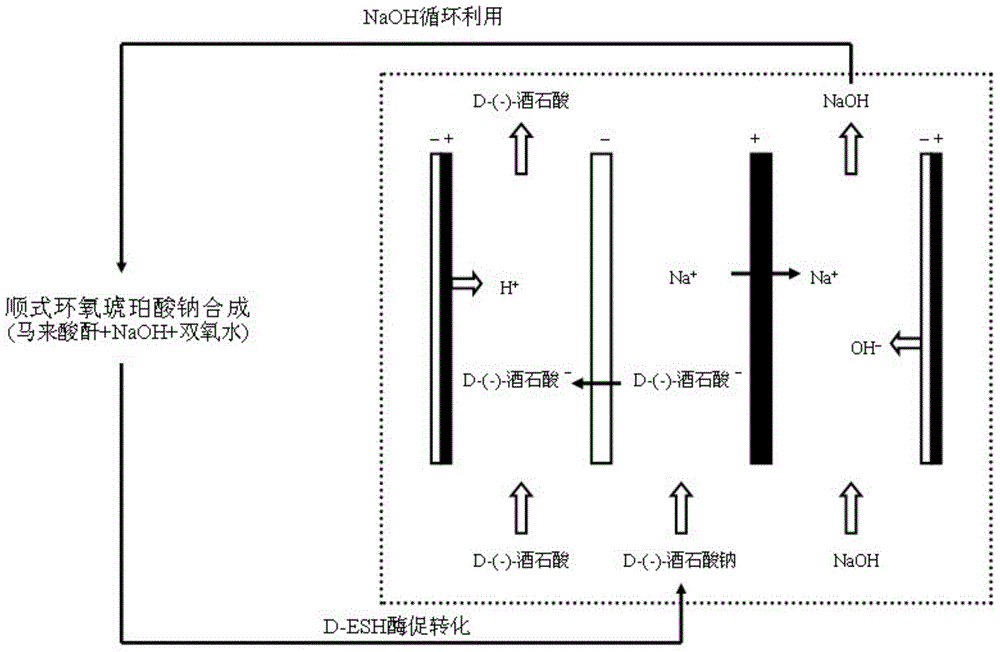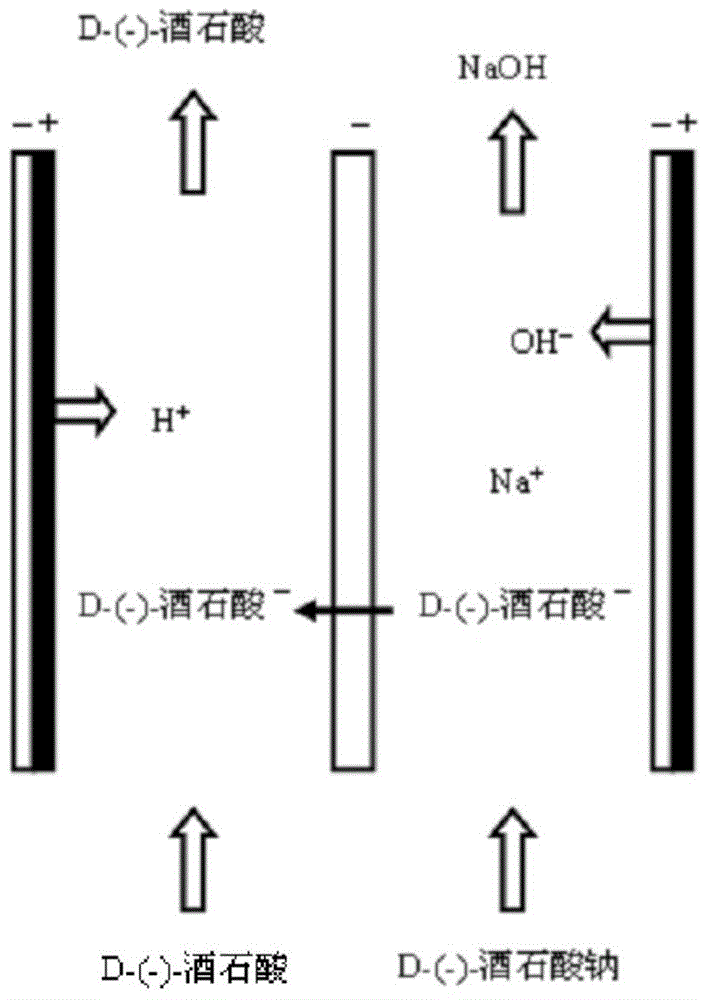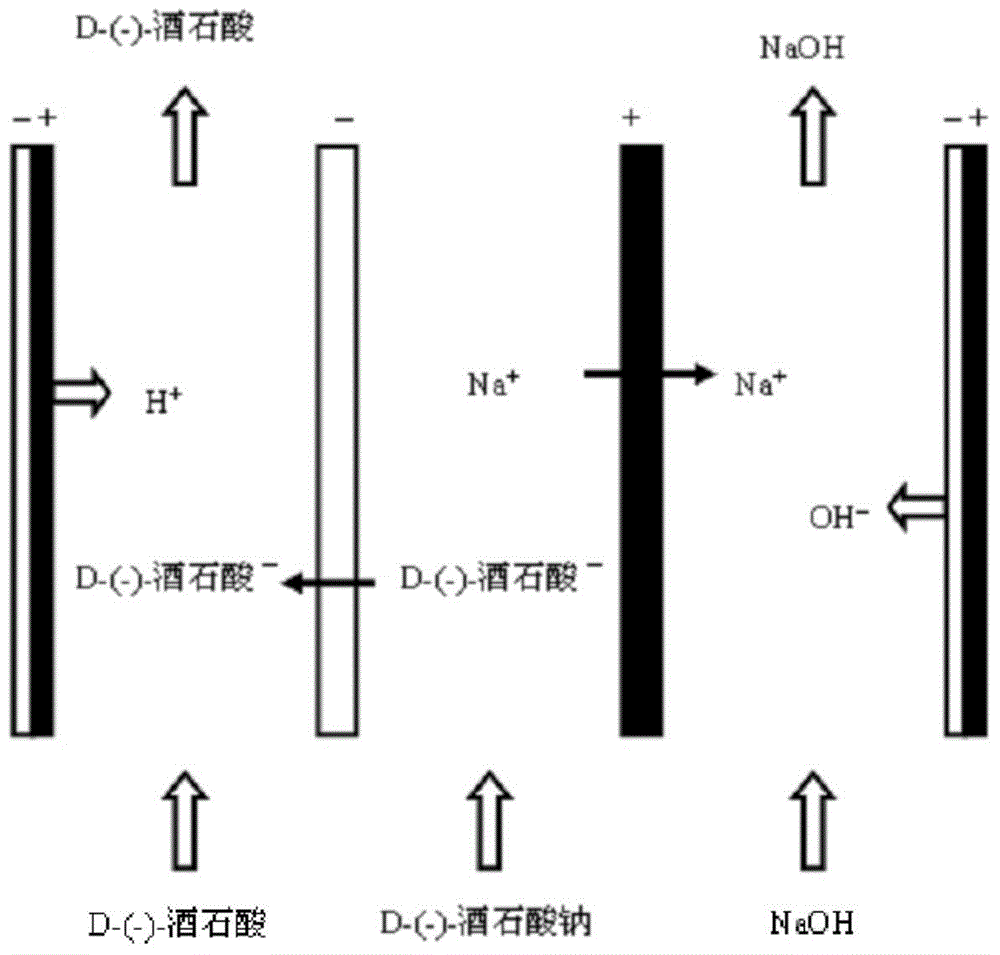D-(-)-tartaric acid clean production process based on bipolar membrane electroosmosis technology
A technology of tartaric acid and sodium tartrate, applied in the fields of carboxylate preparation, organic chemistry, fermentation, etc., can solve problems such as low production efficiency, membrane blockage, low solubility, etc., to avoid cumbersome production steps, significant industrial application value and environmental benefits Effect
- Summary
- Abstract
- Description
- Claims
- Application Information
AI Technical Summary
Problems solved by technology
Method used
Image
Examples
Embodiment 1
[0036] In the following examples 2-4, the model of the bipolar membrane electrodialyzer used is CJ-BMED-A, produced by Hefei Kejia Polymer Material Technology Co., Ltd., with an overall size of 650×650×950mm, and a membrane stack The size is 170mm×110mm, and the ion exchange membrane is acid and alkali resistant. Preparation of Example 1D-type cis-epoxysuccinate hydrolase and its enzymatic hydrolysis
[0037] The gene fragment of SEQ ID NO: 1 was connected to the pBV220 plasmid vector, and then the recombinant plasmid was introduced into E.coliDH5α competent cells to obtain recombinant D-type cis-epoxysuccinate hydrolase engineering bacteria. The cultivation conditions of engineering bacteria are as follows: put 100mL of LB medium in a 500mL Erlenmeyer flask, pick a single colony of engineering bacteria and insert it into the medium, place it at 37°C and shake it at 200rpm. When OD600=0.6-0.8, set the temperature After raising the temperature to 42°C for 5 hours, the inductio...
Embodiment 2
[0039] Example 2 Salt / acid two-chamber electrodialysis device prepares D-(-)-tartaric acid
[0040] 2L is pumped into the salt chamber of salt / acid two-chamber electrodialyzer ( figure 2 ), while pumping 0.5L of 0.2M D-(-)-tartaric acid solution into the acid chamber at a rate of 40L / h to increase its conductivity. Control the voltage to maintain the current density at 140mA / cm 2 , the operating temperature is 40°C, the cycle reaction is 6h, the conversion rate of D-(-)-tartrate reaches 86%, the energy consumption is 2.09kW h / kg, the current efficiency is about 88%, and the D-(-)-tartrate The recovery rate reaches 95%.
Embodiment 3
[0041] Example 3 Acid / salt / alkali three-chamber electrodialysis device prepares D-(-)-tartaric acid
[0042] 2L is pumped into the salt chamber of acid / salt / alkali three chamber type electrodialyzer ( image 3 ), while pumping 1L0.2M D-(-)-tartaric acid solution into the acid chamber at a speed of 60L / h, and pumping 1L0.1M NaOH solution into the alkali chamber at a speed of 60L / h to increase its conductivity . Control the voltage to maintain the current density at 80mA / cm 2 , the operating temperature is 40°C, the cycle reaction is 6h, the conversion rate of D-(-)-tartrate reaches 90%, the energy consumption is 2.64kW h / kg, the current efficiency is about 90%, and the D-(-)-tartrate The recovery rate reaches 98%.
PUM
 Login to View More
Login to View More Abstract
Description
Claims
Application Information
 Login to View More
Login to View More - R&D
- Intellectual Property
- Life Sciences
- Materials
- Tech Scout
- Unparalleled Data Quality
- Higher Quality Content
- 60% Fewer Hallucinations
Browse by: Latest US Patents, China's latest patents, Technical Efficacy Thesaurus, Application Domain, Technology Topic, Popular Technical Reports.
© 2025 PatSnap. All rights reserved.Legal|Privacy policy|Modern Slavery Act Transparency Statement|Sitemap|About US| Contact US: help@patsnap.com



